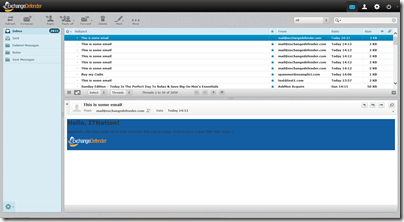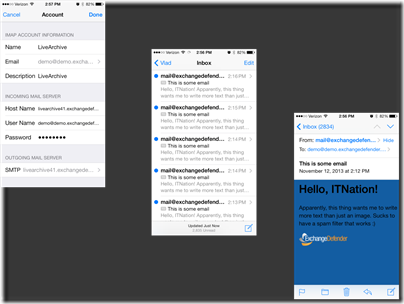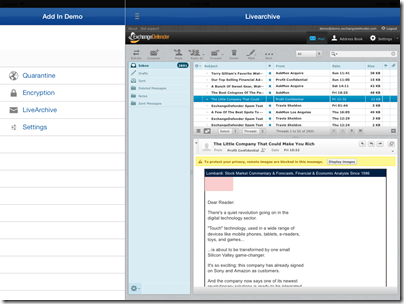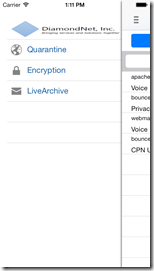SMTP Security Outlook 2010, 2013 & Desktop Client – Major Update
Today we’ve published an update to the Outlook 2010, 2013 and Desktop Client SMTP Security application. This update addresses several bugs, performance issues and even a few feature requests!
- We’ve added the ability to view and manage alias accounts. (See Figure 1)
- An issue where the submission of multiple spam messages at once has been fixed.
- Messages submitted as SPAM are now sent to the “Junk” folder.
- Fixed several performance issues relating to “Hanging” or “Freezing”.
- We’ve fixed the issue that was causing the “Add-In” tab to be renamed.
- We’ve added the ability to disable the automatic refresh cycle. (See Figure 2)
- Fixed an issue that was causing compliance messages to not populate.
- Fixed an issue that caused the quick links to not work correctly. (See Figure 3)
If you currently have the add-in installed, simply close and re-launch outlook. If you had our most recent version previously, the add-in should automatically update. However, if you notice that an automatic update did not occur, simply uninstall the old version and obtain the latest version.
Downloads
Figure 1 – Ability to view and manage alias accounts.
You alias accounts will populate in this list in the order of the main account, then followed by domain and users alphabetically.

Figure 2 – Ability to disable automatic refresh intervals.
You now have the option to disable the automatic synchronization.
Figure 3 – Fixed an issue that caused the quick links to not work correctly.
Clicking this link will sign you into your web management console automatically!
![]()
On The Road Again
ExchangeDefender team is hitting the road again this month and we’d love to see you. We will be at the Automation Nation / Labtech event in Orlando, Datto event in Las Vegas and Autotask conference in Miami. If you’re planning to attend any of these events please stop by, we’d love to see you.
Why do we sponsor these events?
 Historically, we have sponsored IT trade shows as a method of leads generation – we wanted to partner up with IT solution providers across the globe and help deliver email security solutions everywhere. Our approach and our reason for attending events changed last year.
Historically, we have sponsored IT trade shows as a method of leads generation – we wanted to partner up with IT solution providers across the globe and help deliver email security solutions everywhere. Our approach and our reason for attending events changed last year.
Last year we made a decision to close our partner program to new solution providers and focus on helping our existing partner base thrive. This is an organization-wide effort with almost every department exclusively focused on helping our loyal partner base grow faster. Last fall we launched the ExchangeDefender Migration & Support service which gives us the ability to deliver our solutions on our partners behalf directly to the end user – allowing the partner to grow faster and be far more profitable with larger projects. We are no longer at trade shows to get new partners, we are at the trade shows to talk to partners about what is working and how to become more effective as a team.
If you do attend an event and would like to sit down with one of us for a longer conversation – let us know. We would love to talk about how our products and services are working around the world, how different verticals are being served, how these solutions are presented and sold. It’s a massive effort – and one that has a great deal of variety from business to business.
Our team is hitting the road to see you face to face, if you’d like to know more come and see us. If you can’t make it to these by all means, call us and email us, we’d gladly do whatever we can to help.
Sincerely,
Vlad Mazek
CEO, ExchangeDefender
Exchange Essentials Relaunch
Hello partners, Vlad here, bringing you the latest news about the most anticipated launch we’ve had all year: Exchange Essentials. If you haven’t seen the webinar about the new service(s) please click here to watch it:
In short, we found that lots of people were using our Exchange Essentials to serve the segments of the market that we didn’t think would find Microsoft Exchange appealing. We were surprised both on the low end (for part time businesses, MSPs that were tired of supporting POP3/IMAP) and on the high end (bigger companies that wanted to save costs and didn’t need or want the full enterprise look and feel). So we decided to redo the product around our core strengths and help you put out a solution that made a lot more sense. With that, we feel like there are three core values that we bring above and beyond our competitors:
1. You will never go down. Exchange is Exchange, it will go down – when it does, you’ll still have Emergency and LiveArchive to send and receive mail.
2. You won’t have to compete with us. Service is only available through our partners, no direct sales.
3. You are getting the best regardless of how much you pay. There is no difference in terms of the infrastructure that is holding your data, you won’t be stuck on slow servers or old versions just because you didn’t pay for the top tier.
So we now have Exchange tiers that are priced below Microsoft and Google Apps and in our opinion offer a far better designed-for-business service. And we did not want to compromise on the solution – which complicates things a little with contracts, prepayments, commitments and different features coming at different price points. So I wanted to give you an idea of what will happen the next time you attempt to order Exchange Essentials from us.
I want to sign up my client for Exchange Essentials..
If you attempt to do so through the portal or over the phone, you will get a message that someone from our management needs to speak with you. I’m not going to sugar coat this: Reality is that we can only make money on these services if we all do our part. Consider the call as a part of presale consulting – we want to make sure you know exactly what the product differences are, how to market them, how to sell them, how to price and them and how to profit from it all.
How are we going to do that? Well, shortly after speaking with one of us you’ll get a welcome packet. Here is what’s in it:
Brandable Marketing Collateral – We’ve built client-facing marketing collateral that just needs your name and your logo (or change it up completely if you wish)
Pricing Guide – Detailed pricing, contracts, requirements and pricing breaks in an easy to understand guide.
ExchangeDefender Essentials Question Based Sales Guide – Sample questionnaire, question sequence and open ended questions that you can ask your prospects in order to determine the best solution for them.
Sample Proposal, Contract and Invoice – Proposal language, sample contracts and item descriptions for your invoice.
Web Site Collateral – Cut and paste info into your web site.
PowerPoint Presentation – Presentation covering Exchange services that can be delivered in under 3 minutes to a non-techie audience, just apply your company colors and logo.
Yes, that’s a lot of stuff but the more we can do to help you the less time you’ll have to spend trying to figure out how to describe this product on your web site or create from scratch.
It’s as simple as that. Exchange Essentials is already available for order in United States and Essentials service with mailbox servers in Australia and Europe will be available starting with June ‘14.
Let’s talk! If you aren’t profiting from the cloud you’re missing out.
Sincerely,
Vlad Mazek
CEO, ExchangeDefender
Compliance Archive – Improved Searching!
Over the last month we have been in the process of improving the architecture behind Compliance Archive. Your information has already been migrated into this new compliance standard and we were able to do this with very little noticeable downtime. The main reason for this improvement was to help enhance database performance and finally be able to offer advance searching and audit reports.
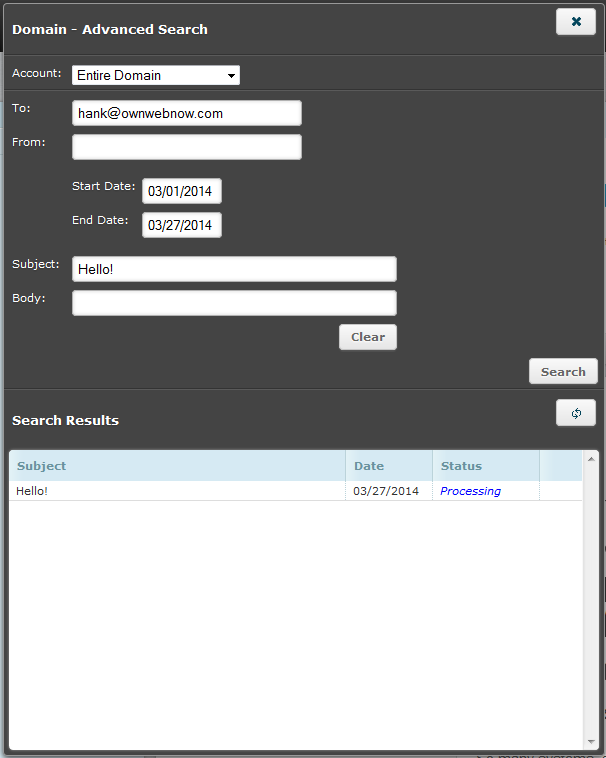
To give you an idea, on the old architecture an advanced report would take roughly 20-30 minutes and would typically time out due to (multiple refreshes) or a user’s browser becoming unresponsive. So before we built the GUI to allow for these searches, we had to get this under control.
Now with the new system not only do searches come back typically within 3-4 minutes, they are scheduled jobs. So you type in your search, submit your criteria and either wait or check back once they have finished. The best part is, you can REPEAT your searches once they’ve finished! So let’s say you’re required to perform the same mundane search once a month, now you can with only a few clicks!
ExchangeDefender & Exchange 2013 Essentials Changes
ExchangeDefender Essentials and Exchange 2010 Essentials have been some of the most popular products in our portfolio for the past year or so. Originally designed as a compromise between “Enterprise” and “Essential”, the products were designed with IKEA principle in mind: “We started with the price… and built a product around it.”; Due to the products popularity and demand we have redesigned 2013 network from the ground up and would like to share the details of the changes that are coming up in April:
ExchangeDefender & Exchange 2013 Essentials
Wed, Mar 26, 2014 12:00 PM – 1:00 PM EDT
https://www1.gotomeeting.com/register/896377176
On the original 2007 network we ran pricing specials as we reached capacity on our large scale clusters where we could fit a few hundred mailboxes before building another mailbox cluster. With 2010 we had an Essentials system that was identical to our Business setup but without data center redundancy and business continuity – something many could easily live without until they had an issue or their needs grew. During this time we were presented with many usage scenarios in which Essentials simply made a lot of sense.
With 2013 we are expanding the Essentials portfolio to present both new solutions as well as new pricing points to give our partners working in home and micro-business settings a way to create a solution that fits these new concerns. While the focus is clearly on paying only for the essentials, the business model will allow the client to compromise only in the areas they desire to based on the environment they manage – we have made many of the product features optional, adjusted the SLA, adjusted support and business continuity offerings, and a lot more that will be discussed on March 26th.
Please take a moment to register for the webinar and we look forward to sharing the new product suite with you!
Vlad Mazek
CEO, ExchangeDefender
vlad@ExchangeDefender.com
Notes from the World Tour
 Over the past month I’ve visited our partners around the world and talked to at least half the countries that we do business in. In case you’re curious, the mood worldwide is the same – from Chicago to Dubai, London to Sydney – business is hard but everyone is optimistic and working hard. We have some of the best IT Solution Providers in the world and I have no fear that everyone will triumph over the regional issues – my primary concern and point of all the trips was to understand what we can do to help our partners move faster.
Over the past month I’ve visited our partners around the world and talked to at least half the countries that we do business in. In case you’re curious, the mood worldwide is the same – from Chicago to Dubai, London to Sydney – business is hard but everyone is optimistic and working hard. We have some of the best IT Solution Providers in the world and I have no fear that everyone will triumph over the regional issues – my primary concern and point of all the trips was to understand what we can do to help our partners move faster.
My primary talking point was our new migration service: Why waste time on administrative and detailed work when we will do it under your name, your brand and process? It’s always thrilling to watch the reaction go from “that’s sounds nice but I think we have it under control” to “oh my god, I had no idea how much time we’re wasting” – so it was the profitable trip to say the least.
Here are some notes on my commitment for the rest of the year.
Partner communications – things have changed: If I had a penny for every time I heard “I didn’t know you guys did that” I probably would have brought more staff along with me and just left them there. I understand our portfolio is extremely broad but the change we are undertaking – from being a partner focused software company to being a service business – will be involving you a lot more in our process. One part that was particularly disappointing were questions about the issues that have been addressed years ago that still seemed like a problem. We will do our best to help drive partner involvement more in the coming year.
Product marketing – support goes beyond the product breaking: Last year was the record year for partner training and blog posts focused on business building. Pat on the back for all the praise I got for that. Partner feedback was quite clear that selling and positioning our services was quite easy, marketing and differentiating them requires more collateral. I hear you – while we have some comparative marketing collateral it is neither as organized nor easy to find. Most of it was put together for specific deals our partners worked on with us directly and honestly we can do a lot better. Next quarter you’ll see a major refresh in our marketing collateral as well as our process workflows that we’ve started sharing with our migration partners. Everything we do makes us better – except consolidating that information for mass distribution; we’ll get right on that.
User education – value beyond the essentials: The age old problem of users getting the solution and then severely underutilizing it is still there but it’s more prevalent these days because of the economy and general expectation for IT costs to be minimal. Almost everyone I spoke to said their clients have pushed for lower rates and even questioned why they were paying for certain services at all that they seemingly never used. Clients that use more than one feature, or are engaged with the product web services (think more web site visits, less email reports) have 9 times more stickiness to the product! Obviously we all have a vested interest in educating our clients about the solution they are paying for – and as we transition to a more service oriented business I expect we’ll help solve the real problem of why users aren’t relying on more of the solution: Someone has to do the work of rolling this stuff out and training everyone how to do it. We’ve got a plan for this as well and I look forward to sharing it with you.
 In summary, this was an incredible trip. It was a pleasure and an honor to be invited to so many businesses and spend some fun time with so many of you as well. I got to bring my son along for the trip so he can see what daddy does, and particular shout out to Greg Lipschitz from Summit IT for taking us around to hang out with the local wildlife. Everywhere I go I am always told “things are different here” but in the end there are just nuances in business preferences – we all share the same annoyances, challenges, difficulties and also the same opportunities.
In summary, this was an incredible trip. It was a pleasure and an honor to be invited to so many businesses and spend some fun time with so many of you as well. I got to bring my son along for the trip so he can see what daddy does, and particular shout out to Greg Lipschitz from Summit IT for taking us around to hang out with the local wildlife. Everywhere I go I am always told “things are different here” but in the end there are just nuances in business preferences – we all share the same annoyances, challenges, difficulties and also the same opportunities.
I appreciate the hospitality and look forward to sharing significant progress on the three points above on my next trip around the world. We certainly have our work cut out for us and the major global initiative as well as the service oriented business model will go a long way towards getting that done.
ExchangeDefender World Tour
Our world tour kicked off in Chicago in January and I’m about to leave Australia for Dubai. It’s simply amazing to see how well our solutions are received worldwide and how the migration product message resonates with solution providers worldwide.
Australia (Sydney & Melbourne) – February 3-8
Dubai – February 9 – 11
UK (London & nearby) – February 12-16
USA – All day every day
While we are primarily promoting our migrations service, the second most discussed solution concerns Compliance Archiving and helping companies deal with compliance and locating what is becoming a growing problem in businesses small and big: information overflow. I’ve been sitting down with partners and discussing common challenges they face in helping small businesses not only operate better but also manage the mountain of information they have built up. As one partner noted: “Years ago they had one filing cabinet for the whole company and a single person could locate any contract or agreement. Now each employee has dozens of cabinets of their own and discovering who said what and when is turning into a logistical nightmare”; I can personally relate to this a lot and I’m very happy to go over how we can help businesses manage this better and have a private Google of their own for the business intelligence they have collected.
The 365 Elephants In The Room
Technologically, I have nothing against Office 365. Exchange is Exchange no matter where it is. Even business-wise, I think their plan selection effectively separates big business from consumer levels.
My main message to partners and my biggest point of differentiation is that our solution is built for a business. From the ground up everything is designed, supported and documented in a way to facilitate business critical operations where one minor issue immediately becomes an emergency as the whole business runs on it. This is where our differentiation and our people and our process and our LiveArchive make an enormous difference and where we ultimately build our solution.
Unfortunately, many discover this differentiation once the consumer solution fails them. When they have to spend time on the phone waiting for support, or a random outage takes hours or days to resolve. At that point they realized they are running business critical systems on a consumer platform with the customer service and support that explains the low end pricing. Everything is great until you need something and then realize that what you have doesn’t fit your needs.
That said, the entry level Exchange and low pricing is not a compromise we will be pursuing. In all of my discussions with service providers these cloud services are already included in the managed services cost. How do more sophisticated partners handle inquiries about Office 365 or Google Apps?
We have a solution that uses exactly the same technology on the backend but it’s build for business by the partners that we have worked for years and we trust. In addition to what you see with Office 365 you also get 1 year of business continuity so when there is a service interruption you can continue to send and receive email. There is also encryption in the product as well as advanced junk mail management so you never miss important messages. And we should also discuss compliance.
Need a desktop version of Office? We can either get you a subscription for $99/year or buy one outright that you own.
It’s that simple.
Migrations = Revenues
It’s a thrill to hear how my message in the presentations across the globe resonates with partners. Everyone sees a different value in ExchangeDefender handling the mail moving portion of the job. Some see additional revenues. Some see decreased costs. Some see more customers faster.
Everyone sees the opportunity to grow. Which is why we chose to dedicate so much of our effort to it.
As I like to mention in my presentations, the secret to success and profits is two fold: “Either find a way to make your revenues by doing less, or find a way to sell more at a higher cost.” With pricing being the eternal argument, the only way we can make our partners grow consistently and quickly is by helping do more of your work. Migrations are just the start and we are doing remarkably well with it worldwide. With each project we get better and learn to manage expectations better and improve our process – something that our partners hopefully never have to go through again. With us handling Outlook/Exchange and partners managed offerings taking care of the user/desktop, the ability to move to the cloud quickly and grow your client base as fast as you can reach/sell them is simply a recipe to follow in 2014.
We are simply making it impossible for you to turn this down in 2014.
I’m happy to say that I’m hearing that loud and clear on two continents so far ![]() Now off to Dubai and Europe.
Now off to Dubai and Europe.
Sincerely,
Vlad Mazek
ExchangeDefender 2014 Strategy Webinar
It’s important for our partners to understand what we are doing, how and why. We put more priority than most other companies mostly because we are small and the only way we succeed is if our partners do as well. With the MSP and IT marketplace wondering which vendors are going to make it through the year all you have to ask yourself is if you will – because if you do so will we. Everything we are doing at ExchangeDefender (and Shockey Monkey) is about helping our partners grow faster. To hear about it in detail please download the webinar we recorded yesterday:
ExchangeDefender 2014 Strategy Webinar
http://www.ExchangeDefender.com/media/XD2014Strategy.wmv
Growth
Every partner I talk to is focused on growing their revenues. Unfortunately growth, as predicted years ago, is coming at a more expensive rate than it did years ago. Not only is there a smaller pool of customers to pick from but the talent is scarce as well – so you will spend more on marketing and more on staffing.
By taking care of migrations, customer service, billing and even marketing assistance ExchangeDefender can help partners acquire more business and deliver more solutions faster. While that sounds like middle management lingo the truth is that you can grow faster if you can deliver more because you aren’t doing all the work yourself.
This is why we are doing what we are doing – our partners look to us to take care of the time consuming, schedule inconvenient, error prone and delicate parts of managing email and cloud solutions. They look to ExchangeDefender to create accounts, move email, configure Outlook clients – all simple and trivial activities that are remarkably time consuming and take lucrative projects into barely breakeven business. If ExchangeDefender can do it for you for free, why would you want to do it yourself?
Limited Time Opportunity
SBS is dead. Microsoft has priced out the rest of it’s solution stack way out of the typical IT budget of a small or medium sized business and when you layer on the cost of management and the cost of IT talent you see why the change is so significant. Even sophisticated IT providers are looking at the onsite infrastructure as a pain point because talent to manage those devices and servers is so expensive and so difficult to replace, combined with the incessant marketing for the cloud it is a losing proposition on multiple levels.
Don’t misunderstand what we are saying – the “move to the cloud” is not something that will go on for years. Last massively deployed SBS version launched in 2008 and those servers are well out of warranty by now. Over the next 2-3 years most of those customers will make it to the cloud and past that point the “move” will no longer have a significant amount of clients to make it worth while holding 6 figure Exchange and SharePoint specialists on staff.
This is why we are doing what we are doing – providing migration and support assistance to help you get your clients to the cloud is our embrace of the marketing and the pressing need in the marketplace. At the time that everyone is demanding it. If you aren’t talking to your clients about the cloud someone else is and the time to move them is now – but should you hire people just for a short term project to get this done? We feel like we can help there as well.
Success Beyond Traditional IT
I am always asked by partners and IT folks what I would do if I were in their shoes right now. What would I focus on?
I, Vlad Mazek, would focus on building up a larger revenue stream. The more money you have coming in and the more profitable you become the more bets you can make. I don’t sit in your shoes and I don’t know which specific terrific opportunities you may have in your local region – but I know that the only way you can take advantage of them is if you have the funds to market yourself and the time (read: employees) to convert the opportunity into cash.
This is why we are doing what we are doing – our smartest and biggest partners realize that the bottom of the traditional IT is going to fall out from the profitability chain and will no longer drive value. However, if you hold on to your clients and help them with the mobile, cloud, devices and so on there is a way to sustain margins and move on up.
Tune in, join up
Download the webinar and hear us out – it’s remarkably easy to get into the cloud with ExchangeDefender and so many people are already marketing the solution to your customers that the sales and value proposition is already clear to them: They just need to know how you’re going to help them do it.
We are at the greatest point of SMB IT – you’ve never been able to build a more sophisticated IT environment for less – and many small businesses are jumping on the opportunity. This is your chance to be a part of it without having to do a lot of work, without having to hire a ton of people, without having to work weekends and most importantly: Without having to lose your clients to a third party or pricing power.
We believe that the opportunity in SMB IT has never been bigger than it is now: It should be evident by the fact that we are providing these services without any additional costs. We are literally putting our money where our mouth is: We want to reward our partners for years of loyalty and give you an advantage in the marketplace. Eventually we will start charging for the migration services as bigger and bigger projects show up but right now you have nothing to lose and lots of new business to gain. Call us and let’s get this started.
Sincerely,
Vlad Mazek
CEO, ExchangeDefender
ExchangeDefender Q1 Meeting
 ExchangeDefender is off to a fantastic start and we wanted you, our clients and partners, to benefit from the developments we have under way. We’re strongest and most profitable when we work together and the opportunities we are identifying now will not be open for a very long time so tune in and hear what we’re doing in 2014:
ExchangeDefender is off to a fantastic start and we wanted you, our clients and partners, to benefit from the developments we have under way. We’re strongest and most profitable when we work together and the opportunities we are identifying now will not be open for a very long time so tune in and hear what we’re doing in 2014:
Thursday, January 23, 2014 12:00 PM – 1:00 PM EST
https://www1.gotomeeting.com/register/164640976
ExchangeDefender and Shockey Monkey are taking on new challenges in 2014, the problems businesses face with cloud and mobile services are drastically different than they were in the traditional office client-server-LAN model. As a partner-only company we want you to be on the same page and understand how we can help you grow going forward.
Webinar will be recorded and available on Thursday in our recorded webinars section of the Social tab.
Brief Agenda
Our Q1 meeting will cover the business and technical developments on Q1 and Q2 agenda. Namely, we are doubling down on what works and cutting what doesn’t. Here is the webinar schedule:
Migration Sales Conversation – Role play of MSP and CIO conversation, how to effectively position the migration service in the language that a business owner can undertand. We’ll go over how to explain the process, describe the new service, inform them of the events that will take place during the process and how the problems will be addressed.
Shockey Monkey Update – Brief discussion on the Shockey Monkey strategy and implementation of new integrations with ExchangeDefender, iPhone, Android, internationalization (new languages), wider release of the Unicorn and direct partner model for Shockey Monkey sales to any small business that could use it.
ExchangeDefender Compliance Strategy – Update about the changes to ExchangeDefender Pro and our suite of compliance, failover, backup and file sharing/sync services. We will discuss the way ExchangeDefender creates a platform for secure and compliant communications.
This will be an event for both your techies and your business staff, the opportunity we have to help our partners to get into the cloud the right way and keep the clients protected and compliant with regulatory requirements is a lucrative one – and we are putting all our resources behind you.
See ya on the webinar!
-Vlad
Vlad Mazek, MCSE
CEO, ExchangeDefender
Announcing LiveArchive 4
After extensive beta testing and taking tons of feedback on the design and future of LiveArchive, we are proud to introduce you to our newest version of ExchangeDefender LiveArchive. Available today and with all your email already loaded into the new system. What’s new?
New LiveArchive goes beyond email business continuity – it not only caches your inbound and sent mail but also keeps your contacts, calendars and appointments. It’s available anytime you need it via a secure web site, it is easily accessible from your smartphone and it even use IMAP to get to it from your email software like Outlook or Thunderbird.
Just remember to bookmark https://livearchive.exchangedefender.com
This was an enormous undertaking as a result of everything we’ve learned through the year of running the massive failover service. We’ve retired Microsoft Exchange as it simply could not scale or effectively provide the kind of service the new IT demands. When LiveArchive was conceived most business users had a central server and workstations in close proximity to it, so the biggest demand was to at least be able to access email if anything went down.
In 2014 and beyond things are a lot more complex and everything is in the cloud that never goes down, right? ![]()
Truth is not just that the cloud is far less reliable than advertised but that there is often no centralized point of backup or control of corporate data. Some information is in Exchange, some is on your phone or your iPad, some is on another cloud file sync service and third party subscription services take care of the rest.
Our design challenge with the new LiveArchive was clear: Look beyond email and create a central point of business continuity for all corporate communications. We have built a massively scalable and redundant platform that can pull and receive information from third party services.
This is what we have delivered with LiveArchive and this is the future of ExchangeDefender as a business – providing security and backup for the cloud.
What does it look like?
With Microsoft out of the picture the look and feel of Microsoft Outlook Web Access is replaced with a scalable UI that works great in any browser you may have – which is convenient when you consider the growing variety of mobile devices and tablet/laptop platforms. Just point your browser to LiveArchive and it will find your grid as you authenticate.
During the beta testing process we recommended that our partners configure dormant profiles on their clients mobile phones so that when the downtime does happen they are just a few clicks away from setting up a full communications platform. In fact, once you switch from your native email platform to LiveArchive the experience with the mobile device is exactly the same, it’s very hard to tell the difference.
Please don’t wait for your infrastructure to crash before you look at setting up LiveArchive, partners that don’t track passwords and configurations tend to reset clients ExchangeDefender password as a first impulse reaction to an outage and then deal with another stack of problems on top of the actual outage. But we got you anyhow – our iOS and Android apps will be on the market soon and they deliver the full experience of the LiveArchive right inside of the app.
Don’t worry, you won’t even have to remember the LiveArchive address once you install the app, it’s right there on the shortcut bar:
In summary, it’s cold outside and now is the time to check this out. ![]()
Sincerely,
Vlad Mazek
CEO, ExchangeDefender
(877) 546-0316 x500
vlad@ExchangeDefender.com


